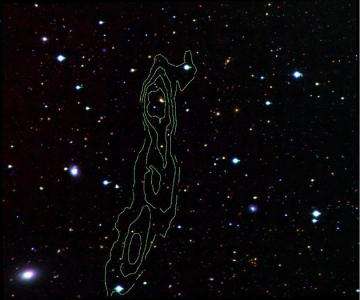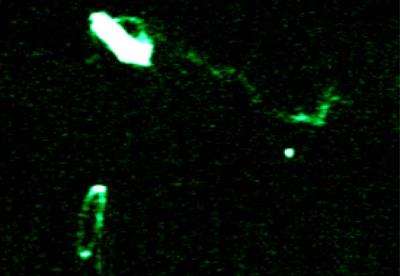New evidence for a Dark Matter Galaxy

New evidence that VIRGOHI 21, a mysterious cloud of hydrogen in the Virgo Cluster 50 million light-years from the Earth, is a Dark Galaxy, emitting no star light, was presented today at the American Astronomical Society meeting in Washington, D. C. by an international team led by astronomers from the National Science Foundation’s Arecibo Observatory and from Cardiff University in the United Kingdom. Their results not only indicate the presence of a dark galaxy but also explain the long-standing mystery of its strangely stretched neighbour.
The new observations, made with the Westerbork Synthesis Radio Telescope in the Netherlands, show that the hydrogen gas in VIRGOHI 21 appears to be rotating, implying a dark galaxy with over ten billion times the mass of the Sun. Only one percent of this mass has been detected as neutral hydrogen – the rest appears to be dark matter.
But this is not all that the new data reveal. The results may also solve a long-standing puzzle about another nearby galaxy. NGC 4254 is lopsided, with one spiral arm much larger than the rest. This is usually caused by the influence of a companion galaxy, but none could be found until now – the team thinks VIRGOHI 21 is the culprit. Dr. Robert Minchin of Arecibo Observatory says; “The Dark Galaxy theory explains both the observations of VIRGOHI 21 and the mystery of NGC 4254.”

Gas from NGC 4254 is being torn away by the dark galaxy, forming a temporary link between the two and stretching the arm of the spiral galaxy. As the VIRGOH1 21 moves on, the two will separate and NGC 4254’s unusual arm will relax back to match its partner.
The team have looked at many other possible explanations, but have found that only the Dark Galaxy theory can explain all of the observations. As Professor Mike Disney of Cardiff University puts it, “The new observations make it even harder to escape the conclusion that VIRGOHI 21 is a Dark Galaxy.”
The team hope that this will be the first of many such finds. “We’re going to be searching for more Dark Galaxies with the new ALFA instrument at Arecibo Observatory,” explains Dr. Jon Davies of Cardiff University. “We hope to find many more over the next few years – this is a very exciting time!”
Source: PPARC















